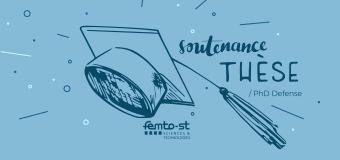You are here

Maha REDA : "Mechanobiological modeling of vibration-induced intimal hyperplasia
Tuesday 5 July 2022 - 2.00 P.MAbstract : Acute exposure to hand-arm transmitted vibrations (HAVs) may decrease the Wall Shear Stress (WSS) exerted by the blood flow on the arterial endothelium. In the case of chronic exposure to HAVs, these WSS changes can lead to arterial growth and remodeling potentially induced by an intimal hyperplasia phenomenon. Accordingly, a mechanobiological framework of an agent-based model (ABM) coupled with a finite elements model (FEM) was elaborated. The ABM captures the hemodynamics-driven and mechanoregulated cellular and molecular mechanisms involved in vibration-induced intimal hyperplasia, such as the secretion of mediators by the endothelial cells (ECs) and the smooth muscle cells (SMCs), the proliferation, apoptosis and migration of the SMCs and the synthesis and degradation of the extracellular matrix (ECM). The input data of the model are the WSS values varying during time according to the presence or absence of vibration during a long-term working condition. The circumferential stress values were simulated in the FEM that describes the mechanical behavior of digital artery. The mechanobiological model was combined with flow loop experiments that investigated the WSS-modulated secretion of the Platelet-Derived Growth Factor BB (PDGF-BB) by the ECs. The model rules parameters were obtained using our experimental findings and literature data. The model was able to replicate the basal state (no vibration) as well as predict a 30 % stenosis resulting from a chronic drop of WSS values mimicking exposure to vibration during a timeframe of 10 years. The study of the influence of different WSS-modulated phenomena on the model has shown that the magnitude of stenosis largely depends on the migratory and mitogenic effects of PDGF-BB and Transforming Growth Factor β (TGF-β) on SMCs. A parametric study was conducted to study the effects of some parameters, such as diffusion coefficient of PDGF-BB for example, on the onset of intimal hyperplasia. The results also proved that the fall in circumferential stress due to arterial layer thickening to a great extent accounts for the degradation of the ECM in the media. Fully coupled simulations of five years duration has suggested that the mechanical behavior employed in the FEM for the digital artery had no effects on the arterial stenosis rate.
Jury composition :
Jean-François Ganghoffer (Université de Lorraine, LEM3)
Vittorio Sansalone (Université Paris Est créteil Val de Marne, Modélisation et Simulation Multi-Echelle (MSME))
Anne-Virginie Salsac UTC ( Biomechanics and bioengineering laboratory)
Alice Turcot (Direction de santé publique, CISS Chaudière-Appalaches)
Nicla Settembre (Université de Lorraine, CHU Nancy)
Christophe Lang (UFC, FEMTO-ST DISC)
Christophe Noël ( INRS)
Emmanuelle Jacquet (UFC, FEMTO-ST, DMA)
Localization : INRS Nancy - Salle de conférence Batiment 29 - 1, rue du Morvan 54500 VANDOEUVRE-LES-NANCY









